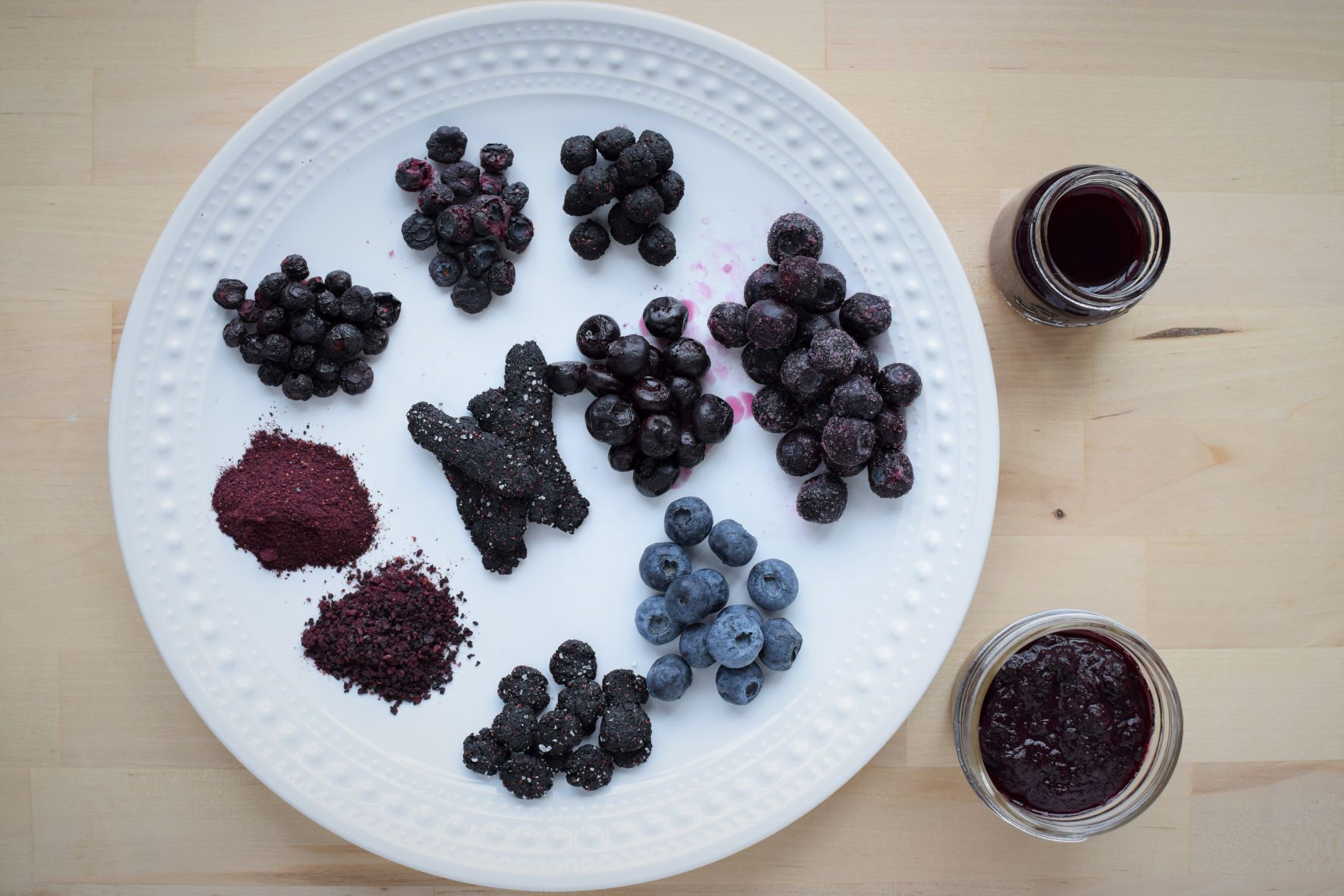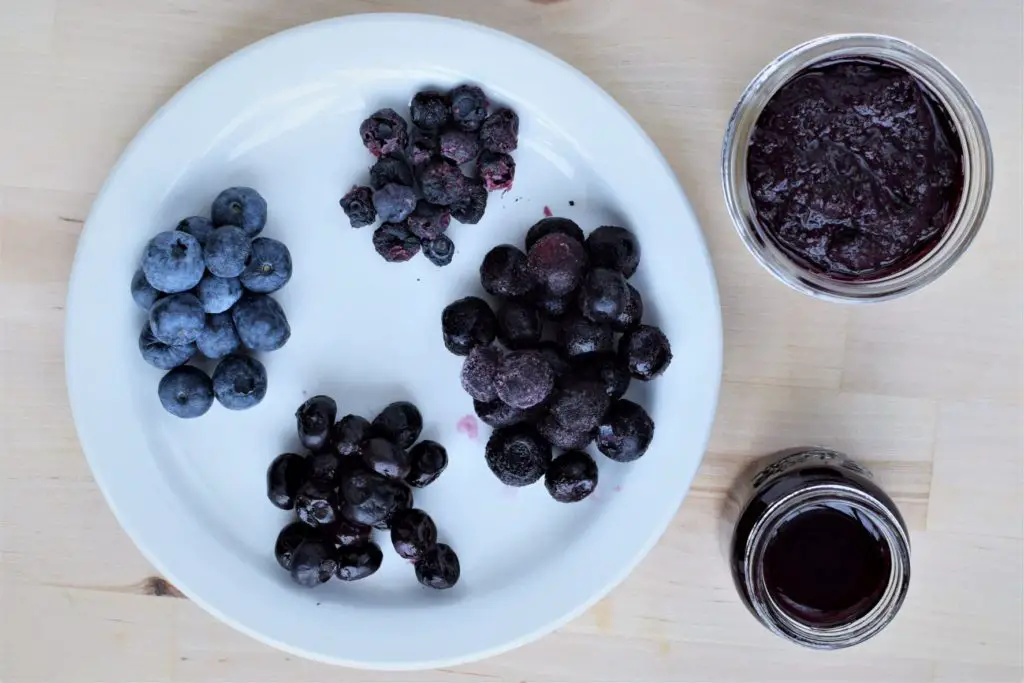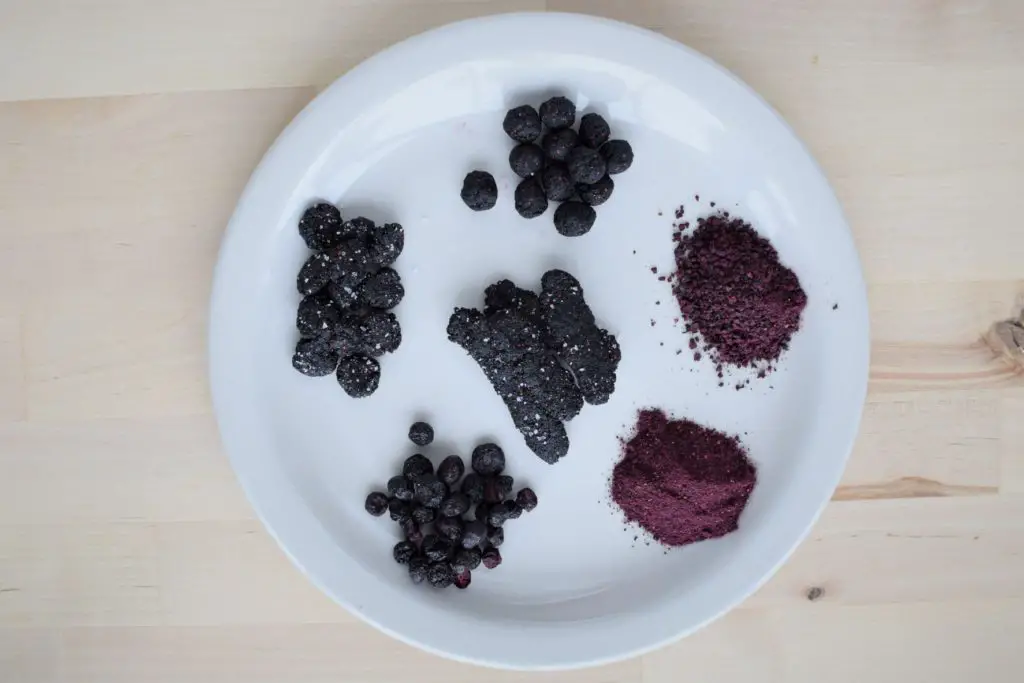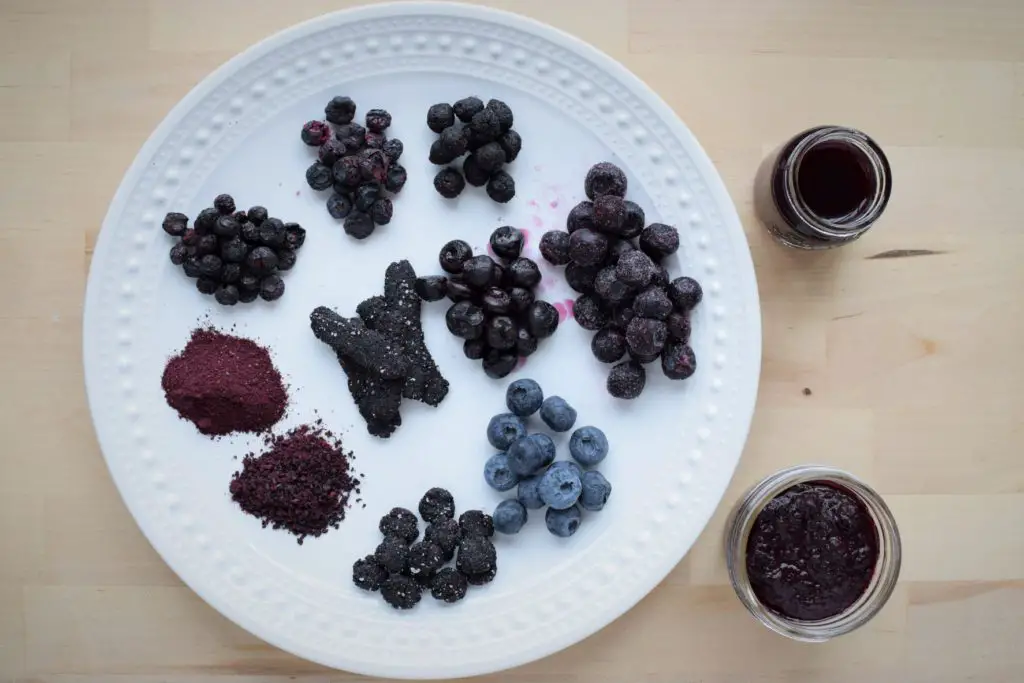FPIES Blueberry Food Options

No one wants to eat one flavor and one texture all day every day. We want and NEED variety in our food to make eating an enjoyable experience instead of a mundane task. Well, I have found the same is true with kids. I saw the growing lack of interest in Ellie’s sole offering of blueberries before we were able to add millet. Just like squash and other FPIES trialed and then eventually failed foods, the single food option lacks interest after a while. I have pulled previous knowledge from squash offerings (here and here) as well as digging deep into the kitchen cabinets for all the tools (not really). Because I know Ellie isn’t the only one in this FPIES and food allergy boat, I want to share with you Ellie’s FPIES blueberry food varieties.
Blueberries vs Butternut Squash
First let me just say blueberries are so much tastier by themselves than squash. This I feel like gave us a step up in our offerings, because who wants a butternut squash popsicle? Not me and not Ellie either. And since my husband and I eat all of Ellie’s FPIES blueberry options with her, I am so thankful to be on blueberries. Roasted blueberries are little jewels of sweet juicy goodness – I would have never known.
FPIES foods book of Wisdom
For those who haven’t had the chance to look at the FPIES Handbook, I highly recommend it, especially if you are just starting your FPIES journey. This book has some great information even though there aren’t really hard and fast rules when it comes to this dratted FPIES – such a rude disease! At least this book supplies you with some guidelines through knowledgeable and researched information.
The FPIES Handbook lists blueberries as a low FPIES risk food, and bonus for Ellie, blueberries have a lower fructose level. Yahoo! So blueberries are a winner. Ellie has trialed blueberries before, had to have a period of gut rest, was back to trialing blueberries, and then eventually passed. Hooray safe foods! Have I mentioned how rude, insensitive, and just downright unfair FPIES is? If you want to learn more about Ellie’s FPIES journey, please join us here to follow along as we tackle this bully of a disease.
Thankfully as I mentioned before, blueberries are delicious and – thanks to being able to buy them fresh, frozen, and freeze dried – we were able to come up with a myriad of options for Ellie with numerous textures and even some variance in taste.
Here are many ways to present blueberries with varying texture and yes, even flavor!
‘Whole Blueberry’ Options for FPIES

Fresh blueberries
Cut to size that is appropriate for age.
Frozen blueberries
Our favorites are the Costco frozen Organic blueberries – so sweet! Cut to size that is appropriate for age.
Dehydrated blueberries
Place frozen or fresh blueberries in a dehydrator (this is the one I use, affordable and works well – what more could you ask for.) I like to use fruit leather tray inserts which make the blueberries easy to remove when they are done. I follow these instructions from Getty Stewart and they work great! Surprisingly the blueberries are even a bit sweeter after dehydrating them.
The dehydrated blueberries are a nice change for Ellie, because she is adamantly opposed to the ‘squishiness’ of the insides of fresh and frozen blueberries. Yeah, we are working on that.
Roasted Blueberries
These roasted blueberries are by far, my absolute, hands down, no doubt about it, favorite way to eat blueberries. All blueberries. Just delicious – even if you don’t HAVE to eat blueberries, you can CHOOSE to eat these little gems. Hey, have I mentioned these are incredibly good?
On a silicone baking mat (my preference), foil, or parchment paper lined baking sheet, roast fresh or frozen blueberries in a 350 degree Fahrenheit oven for 20-30 minutes. That’s it and that’s all to get such a tasty treat! And yes, I do share these roasted blueberries with Ellie too.
Blueberry Puree
Pour frozen blueberries or washed fresh blueberries into a saucepan and add a splash of water to the pan. Cover and cook over medium to medium-low stirring occasionally. When blueberries are all starting to break down and cook, reduce to a simmer and remove the lid. Cook blueberries and reduce to your desired level of liquid. If you want your blueberry puree pretty thin, stop cooking after a few minutes. If you want a thicker puree, continue simmering uncovered on low for 30 minutes to an hour, depending on how many blueberries you started with. Just keep an eye on it, you can always reduce your puree more after you blend it.
Let your cooked blueberries cool for a few minutes off the heat before pouring it into your food processor. When blueberries are just warm, pour contents into your food processor and pulse a few times. Just stop pulsing when you reach your desired consistency.
You can decide if you want smooth puree or more of a textured consistency. With Ellie’s eating therapy we started off smooth and have gradually worked to it having a bit more texture in her puree.
Blueberry puree can be stored in the fridge in a closed container for up to a week or frozen for a couple months.
I feel like this would be the go-to option for most FPIES parents trialing blueberries, as many are trialing foods with a lot younger kiddos than Ellie. Ellie does enjoy her puree, most recently in a pouch – which she squirts out onto a plate or spoon – I’ll take what I can get.
Roasted Blueberry Puree
For an extra sweet, thick, and utterly delicious treat of a puree – use roasted blueberries (see above instructions). Add roasted blueberries to a food processor and blend until desired thickness. This puree is what convinced Ellie to start eating blueberries, I don’t blame her, this stuff is goooood.
Blueberry Juice
When you are cooking your blueberries on the stove (see above in blueberry puree instructions) leave the lid on while cooking the blueberries the whole time. When you are done, strain off as much of the blueberry juice as you want. You can use the left-over blueberries for puree.
Use blueberry juice to flavor water, ice, or mix with water to make popsicles.
You can also paint with blueberry juice if your kiddo is working up to trusting food like Ellie, or even if you are just looking for a safe way for your little FPIES kiddo to do an art project. Fun fact, blueberry juice works great on watercolor paper!
Blueberry popsicles
I have found that being able to offer Ellie an FPIES foods safe popsicle when her older sister is having a frozen treat too has been fantastic! Not only is it a fun way for Ellie to work on eating since she can lick it, suck it, or bite it, but she also can also ‘eat’ just like her big sister! And isn’t mimicking some of the best form of learning?
I use these popsicle molds I love because of their perfect size. I had tried a couple other shapes and sizes and found Ellie to prefer these the most. They don’t drip as easily on her hand and she can hold them no problem – double win for eating confidence!
To make a juice popsicle, use the blueberry juice from above and mix to your desired amount of water. Pour into molds and freeze for a few hours.
To make blueberry puree popsicles, I prefer to use the smooth puree (see above in puree instructions) and mix about 2/3 part puree with about 1/3 parts water. Mix and fill popsicle molds almost to the top. Freeze for a few hours. To easily remove one popsicle at a time I run warm water over the bottom of the mold for one popsicle for a few seconds or until I can gently pull the popsicle out. Another reason why I love this popsicle mold.
I imagine we are going to go through even more of these popsicles during the upcoming summer months!
Blueberry Frozen Shapes
Similar to blueberry popsicles, but just in another shape. I found these and these great silicone candy molds that come in all different shapes. Ellie loves the fun assortment and can play with the dinosaurs or fly the bees around the flowers, well you get the idea. Who would have ever thought playing with food would be encouraged?
Use the same method as the popsicles depending on how much blueberry puree or juice to water ratio you want. Freeze in molds for a few hours and then pop out and store in a closed container in the fridge.
Blueberry Ice Cream
I guess the better name for this would be sorbet, however my 2.5-year-old doesn’t know what ‘sorbet’ is but asks for ‘ice cream’. So, ‘ice cream’ it is!
You can either put your blueberry puree in an ice cream maker on the sorbet setting, if you have one of those. OR you can freeze your puree in ice cube trays and then toss the frozen cubes into a food processer and process until texture of about shaved ice. If you want it a bit smoother than that, stir it a little more as it begins to warm up and the texture does become more of a sorbet. Store in a closed container in the freezer.
‘Freeze Dried Blueberry’ Options for FPIES

Freeze Dried Blueberries
We buy so many of these Trader Joes and these Good and Gather freeze-dried blueberries, we should be offered partial ownership of the companies soon, or at least to be the “Face of Blueberries”.
These “cwunchy boobewies” are the key tool in Ellie’s eating therapy right now. As we are working on her “dinosaur crunches”, these little airy bites are full of crunch potential.
Depending on your child’s age and ability, these freeze-dried blueberries are a great tool in themselves for encouraging interaction with food. From their dry exterior, to their superior crunch potential, to the trusting relationship Ellie developed with freeze dried blueberries over fresh blueberries – these don’t squirt into her mouth when she bites them – Ellie loves her freeze-dried blueberries.
Freeze Dried Blueberry Powder
This is another favorite of Ellie’s, and all the things that it can become. As long as you have a great food processor (like this one, that I wouldn’t survive FPIES cooking without) you can easily whip up this powder versus buying blueberry powder at the low low cost of $100 an oz. Okay I am exaggerating, but making it yourself is really easy and does save some money.
Okay are you ready for the really complicated process? No? Okay good, because it’s incredibly easy!
- Open the freeze-dried blueberry bag.
- Dump blueberries into food processor with the metal blade.
- Process blueberries until you have reached your desired consistency.
- Wait a few minutes before opening the top, or you will dust your kitchen in a fine layer of beautiful bluish-purple powder, it’s happened, but at least it’s pretty.
- You can decide if you want more texture to your powder or if you want it fine, more like flour. We still are using the fine powder as I use it for making her ‘crackers’ most often (see below). If you want fine powder, it takes a minute or two (depending on your food processor) to achieve that consistency.
- Store blueberry powder in an airtight container. I will tell you that this powder absorbs moisture like no body’s business since it is made from freeze dried blueberries. If powder kind of sticks together, just stir it around with a spoon and it will break back up.
Blueberry play ‘dough’
Mix ‘blueberry powder’ (from above) with a small amount of water, stirring after each small addition of water. Start with a very small amount of water and increase from there, it takes a lot less water than you would think to make this powder into dough.
I would make this ‘dough’ at eating times, or just before, and allow Ellie to play with it but also encourage eating at the same time. This ‘dough’ we would then turn into crackers (see below). First though you can shape, squish, mold, roll, and taste!
I know I have mentioned it before, but I think it bears repeating again, playing with food has been essential in building Ellie’s confidence with eating. Also, allowing her to ‘help’ make her crackers by making this ‘dough’ first and then ‘shaping’ it on the silicone baking mat for baking, encouraged her interaction with food before she was truly interested in eating at all.
This ‘dough’ has also allowed her to have a resemblance of play dough since we avoid play dough for her on account of the gluten in it.
Blueberry Crackers
Take the ‘blueberry dough’ from above and form it into smaller shapes on a silicone baking mat lined baking sheet. As you see in the picture, I added sea salt to the tops of the crackers for extra flavor and texture, its up to you if you add that or not, it isn’t necessary.
Ellie really enjoys the ‘sticks’ which are about 2 tsp of dough shaped into flattened lines (see picture). She also loves the ‘cracker bites’ which are small pea sized balls of dough flattened slightly and baked.
Bake these ‘crackers’ at 350 degrees Fahrenheit for 6-12 minutes, depending on the size of cracker you are making. These firm up some after taking them out of the oven, so don’t over bake them too much or they turn into teethers or drum sticks – Ellie has noisy aspirations.
I am sure there are many other ways to eat blueberries, especially if your child actually chews food *crossing fingers for that*. I hope though that these ideas give you a start with variations for presenting one food option.
You don’t have to be limited with one texture and shape. Invest in a good food processor and your options are limitless – unlike a mother’s time.
